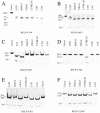Revisiting the mouse mitochondrial DNA sequence
- PMID: 12954771
- PMCID: PMC203322
- DOI: 10.1093/nar/gkg739
Revisiting the mouse mitochondrial DNA sequence
Abstract
The existence of reliable mtDNA reference sequences for each species is of great relevance in a variety of fields, from phylogenetic and population genetics studies to pathogenetic determination of mtDNA variants in humans or in animal models of mtDNA-linked diseases. We present compelling evidence for the existence of sequencing errors on the current mouse mtDNA reference sequence. This includes the deletion of a full codon in two genes, the substitution of one amino acid on five occasions and also the involvement of tRNA and rRNA genes. The conclusions are supported by: (i) the re-sequencing of the original cell line used by Bibb and Clayton, the LA9 cell line, (ii) the sequencing of a second L-derivative clone (L929), and (iii) the comparison with 12 other mtDNA sequences from live mice, 10 of them maternally related with the mouse from which the L cells were generated. Two of the latest sequences are reported for the first time in this study (Balb/cJ and C57BL/6J). In addition, we found that both the LA9 and L929 mtDNAs also contain private clone polymorphic variants that, at least in the case of L929, promote functional impairment of the oxidative phosphorylation system. Consequently, the mtDNA of the strain used for the mouse genome project (C57BL/6J) is proposed as the new standard for the mouse mtDNA sequence.
Figures



References
-
- Bibb M.J., Van Etten,R.A., Wright,C.T., Walberg,M.W. and Clayton,D.A. (1981) Sequence and gene organization of mouse mitochondrial DNA. Cell, 26, 167–180. - PubMed
-
- Earle W.R., Schilling,E.L., Stark,T.H., Straus,N.P., Brown,M.F. and Shelton,E. (1943) Production of malignancy in vitro. IV. The mouse fibroblast cultures and changes seen in the living cells. J. Natl Cancer Inst., 4, 165–212.
-
- Marchington D.R., Barlow,D. and Poulton,J. (1999) Transmitochondrial mice carrying resistance to chloramphenicol on mitochondrial DNA: developing the first mouse model of mitochondrial DNA disease. Nature Med., 5, 957–960. - PubMed
-
- Inoue K., Nakada,K., Ogura,A., Isobe,K., Goto,Y., Nonaka,I. and Hayashi,J.I. (2000) Generation of mice with mitochondrial dysfunction by introducing mouse mtDNA carrying a deletion into zygotes. Nature Genet., 26, 176–181. - PubMed
Publication types
MeSH terms
Substances
Associated data
- Actions
- Actions
- Actions
Grants and funding
LinkOut - more resources
Full Text Sources
Other Literature Sources
Molecular Biology Databases

